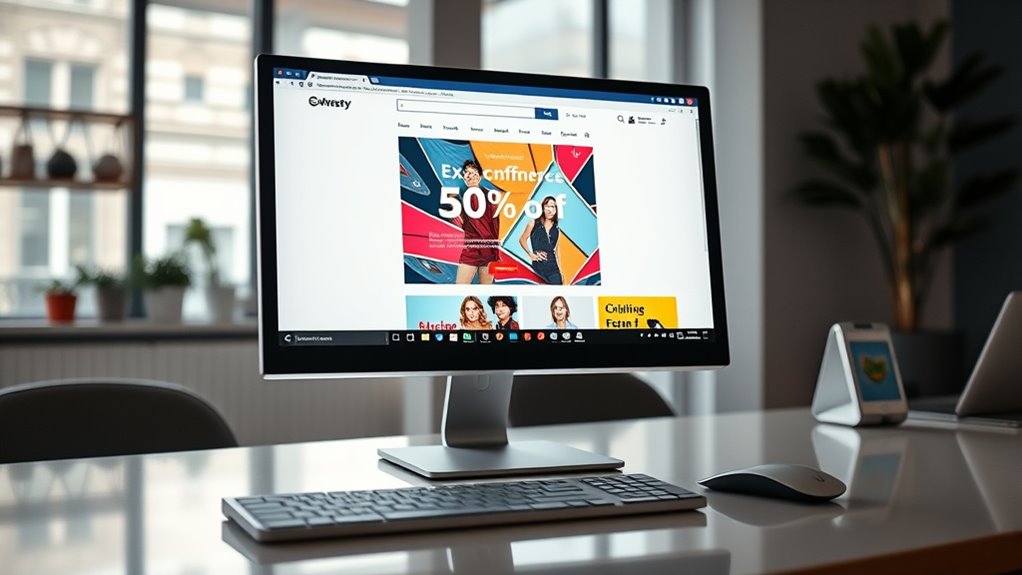Exit‑intent pop-ups can boost your sales if you design and time them carefully, capturing visitors’ attention before they leave. When used correctly, they offer personalized prompts, discounts, or helpful content that encourage action without frustrating users. However, if they’re poorly timed or too aggressive, they may annoy visitors and increase bounce rates. Want to discover how to implement them effectively without irritating your audience? Keep exploring to learn more.
Key Takeaways
- When well-designed and tested, exit-intent pop-ups can effectively increase conversions without frustrating visitors.
- Poorly timed or overly aggressive pop-ups may annoy users, leading to higher bounce rates and negative brand perception.
- Personalization and relevant offers improve user experience, making pop-ups more likely to save sales rather than drive visitors away.
- Continuous A/B testing helps optimize pop-up design and messaging, balancing engagement with non-intrusiveness.
- Overall, exit-intent pop-ups can boost sales if implemented thoughtfully, but misuse can damage visitor trust and site reputation.

Exit-intent pop-ups are a powerful tool designed to capture visitors’ attention just as they’re about to leave your website. They give you a last chance to engage your audience, offer value, and potentially turn a fleeting visit into a conversion. But whether they actually boost your sales or just annoy visitors depends on how you use them. To maximize their effectiveness, you should consider A/B testing different designs, messages, and triggers. This way, you can identify which versions resonate best with your audience and improve user engagement over time.
Exit-intent pop-ups can boost engagement when tailored through A/B testing and strategic timing.
When you implement exit-intent pop-ups thoughtfully, they become more than just a nuisance. Instead, they serve as personalized prompts that speak directly to your visitors’ needs or interests. For example, offering a discount, free trial, or helpful content right before someone leaves can motivate them to stay or complete a purchase. Conducting A/B testing allows you to experiment with different offers, headlines, and visuals, giving you data on what’s most compelling. Over time, this iterative process enhances user engagement because you’re delivering tailored experiences that feel relevant rather than intrusive.
However, it’s essential to strike a balance. If your pop-ups are overly aggressive or poorly timed, they risk frustrating visitors and increasing bounce rates. That’s why refining your approach through testing is vital. For example, you might test a subtle slide-in modal versus a full-screen overlay to see which causes less disruption but still captures attention. Similarly, you can experiment with the wording—whether emphasizing urgency or highlighting benefits—to see what prompts more conversions.
Remember, the goal isn’t just to get visitors to stay longer but to make their last moments on your site meaningful. When used correctly, exit-intent pop-ups can increase your lead generation, sales, and overall user engagement. The key lies in continuous testing and optimization. By analyzing how different pop-up strategies perform during A/B testing, you gain insights into your audience’s preferences and behaviors. This allows you to craft more persuasive, less intrusive pop-ups that genuinely add value instead of alienating your visitors. Leveraging AI analytics tools can further enhance your ability to identify high-performing variations, making your optimization process more efficient.
In the end, exit-intent pop-ups can be a valuable component of your marketing toolkit if you approach them strategically. They’re not a one-size-fits-all solution, but with careful testing and tuning, they can turn a potential exit into a new opportunity for engagement and sales. Just remember, your visitors appreciate relevance and respect—so use data-driven insights to guide your approach.
Frequently Asked Questions
How Do Exit‑Intent Pop‑Ups Affect Mobile User Experience?
When considering how exit‑intent pop‑ups affect mobile user experience, you notice they can be intrusive if not optimized. Ensuring mobile responsiveness is key; pop‑ups should adapt seamlessly to different screen sizes. Using gesture detection helps trigger pop‑ups naturally, respecting user navigation. When implemented thoughtfully, they don’t frustrate users but instead provide timely offers, boosting engagement without disrupting the overall mobile browsing experience.
Can Exit‑Intent Pop‑Ups Be Personalized for Different Visitor Segments?
You can definitely personalize exit‑intent pop‑ups based on visitor segmentation. Picture tailored offers or messages that resonate with each visitor’s interests, increasing engagement. Using personalization strategies, you create relevant experiences that feel less intrusive. This approach not only captures attention but also boosts conversions. By customizing pop‑ups for different segments, you turn a simple exit‑intent tactic into a powerful tool that feels natural and helpful, encouraging visitors to stay or convert.
What Are the Best Practices for Designing Non-Intrusive Exit‑Intent Pop‑Ups?
When designing non-intrusive exit‑intent pop‑ups, focus on clean visual design that’s easy to read and not overwhelming. Use subtle animations and a clear, compelling call to action phrasing that encourages visitors to stay or convert without feeling pressured. Keep the message brief and relevant, ensuring it complements your site’s overall look. Test different designs to find what feels natural and respectful of visitor experience.
How Do Exit‑Intent Pop‑Ups Impact Website Loading Speed?
Think of exit‑intent pop‑ups as a quick gust of wind that can slow your site’s sail. They add code that loads alongside your main page, potentially affecting page load times and site speed. If not optimized, they can create delays, making your site feel sluggish. To keep your visitors engaged without sacrificing speed, guarantee your pop‑ups are lightweight and efficiently integrated into your website’s code.
Are There Legal Considerations When Using Exit‑Intent Pop‑Ups?
When using exit-intent pop-ups, you need to consider privacy concerns and legal compliance. You should inform visitors about data collection and obtain necessary consents, especially under laws like GDPR or CCPA. Failing to do so might lead to legal issues or penalties. Always stay transparent, include privacy policies, and ensure your pop-ups respect user rights to avoid legal pitfalls and build trust with your audience.
Conclusion
Think of exit-intent pop-ups as friendly gatekeepers at a bustling market. When they sense you’re about to leave, they offer a last-minute gift—like a special discount—to lure you back inside. Done right, they’re your secret weapon to turn wandering visitors into loyal customers. But if they’re too pushy, they can feel like a noisy hawker chasing you down. Use them wisely, and they’ll guide your visitors safely to a sale’s doorstep.











